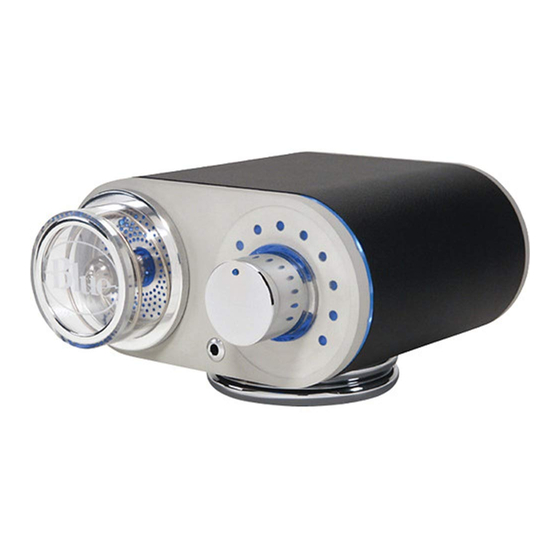Advertisement
-
Project Studio
In collaboration with the Conservatory
of Recording Arts and Sciences, one the
coun-try's
leading pro audio teaching
facilities, PAR has introduced a regular
series of in-depth reviews conducted at
the Conservatory's state-of-the-art teaching
faculty in Phoenix.
BY PAUL RICHARDS
B
lue Microphones' Robbie is a single-
channel Class A discreet tube micro-
phone and instrument preamplifier. It
features an ECC88 twin triode vacu-
um tube, renowned for its balanced and
round musical sound. Its goal is to compete
with vintage and boutique preamps that can
cost considerably
more than its $1,299
MSRP.
The Robbie's design is at once classic and
futuristic. In the tradition of many classic pre-
amplifiers, the Robbie gives the user a clean
and simple signal path. It can achieve 34 dB of
headroom before clipping. The front panel has
a large potentiometer for output gain, a 1/4-
inch instrument input for use as a DI, and a
window to access the tube (or watch it glow!).
The back of the Robbie has a power
switch, XLR microphone in, XLR line out,
48V switch for phantom power, a 20 dB pad
and a polarity reversal switch. You will not
find compression or equalization options; it
was created to only do one thing: provide a
full frequency tone that is warm and detailed.
The Robbie certainly does this very well.
Blue pays tribute to the science fiction sta-
ple Robbie the Robot both in name and in
appearance. Although a younger generation
of engineers might argue the Robbie's design
is more reminiscent of "Number 5," the robot
from Short Circuit, its look is unlike any
other preamp out there and is sure to be a
conversation piece in any studio. While Blue
Microphones made the Robbie to be a visual
centerpiece in the control room, its perform-
ance is what will keep the clients coming
back for more.
I had the opportunity to use the Robbie in
42
Blue Microphones
RobbieMic
Preamp
a numberof differentsituations,
~
and I was very pleased with the
.
results every single time. First I
used it recording acoustic guitar. Thl
sound the Robbie provided was very big.
The detail in the high and midrange fre-
quencies was crisp; the articulation captured
intimacy without any harshness. The low was
very pronounced without being woofy. I
miked a guitar with an AKG C45lB with a
second C451B placed right next it, as
diaphragm-coherent as possible. One was run
through the Robbie and the other through one
of the preamps on a Neve VR. In a blind lis-
tening test at the Recording Conservatory, 23
of 24 students said they like the sound of the
Robbie.
In a different session, I used the Robbie
for a number of different roles. First, it served
as a center drum overhead in a LCR configu-
ration. The drums were handled without any
inkling of overload. The transients of stick
hits were clean, followed by the round sustain
of the drum's shell. Very nice.
I also used the Robbie as a direct box on
bass. This is where the Robbie really shined.
While the track went from smooth and melod-
ic to pseudo-funk slap and pop, the Robbie
stayed clean and punchy. It captured a full low
end which served as a great foundation as well
as smooth upper mids that meant the track did
not require any EQ to separate it in the mix.
The Robbie also served as my primary
mic preamp for tracking vocals. Not only did
the track have a round dimensionality, breath
was also captured that made the performance
very intimate. Again, the track sat out in the
mix without needing EQ. Switching to a sec-
ond microphone for recording a double track
allowed the listeners to really hear the differ-
ence between the two microphones.
Blue's the Robbie microphone preamp was
designed so the user would see something
unique while hearing the warmth, balance, and
detail associated with vintage and boutique mic
preamps that can cost twice as much. While it
is not exactly inexpensive for a single channel,
the Robbie's versatility and outstanding per-
formance,
cou-
pled with its one-of-a-kind appearance make it
a piece of gear any studio would love to have.
Paul Richards is an instructor at the
Conservatory of Recording Arts and Science
in Tempe, Ariz.
Contact
Blue
Microphonesat 818-879-
5200, www.bluemic.com.
Second O~inion
Director of Education,
Recording Arts and
Michael Jones,
Conservatory of
Sciences:
'The Robbie really stood out when I
used its instrument input to track bass.It
deliveredpunchy mids and low end clarity
that allowed the trackto sit both comfort-
ablyand powerfullyin the mixwithout a lot
of effort:'
David
LaBounty,
Instructor,
Conservatory of Recording Arts and
Sciences:
"l\/Bing the same microphonesthrough
the stock console preamps and the
Robbie was a night and day difference.
The Robbie had a hotter output while
being warmer and 'rounder."
Matthew Luckett, Head Supervisorof
Student Projects, C RAS:
"Beinga drummer I want the drums,
especially the kick,to sound huge,and the
Robbiegivesme that soundwithout having
to push gain stagingor addingequalization
and compression. I t hasdeep, detailedlow
end that is not unnaturallyemphasized:'
Pro AudioReview
-
June 2005
Advertisement
Table of Contents


















Need help?
Do you have a question about the Pop and is the answer not in the manual?
Questions and answers